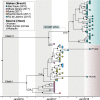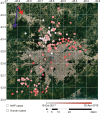Origin of the São Paulo Yellow Fever epidemic of 2017-2018 revealed through molecular epidemiological analysis of fatal cases
- PMID: 31892699
- PMCID: PMC6938505
- DOI: 10.1038/s41598-019-56650-1
Origin of the São Paulo Yellow Fever epidemic of 2017-2018 revealed through molecular epidemiological analysis of fatal cases
Abstract
The largest outbreak of yellow fever of the 21st century in the Americas began in 2016, with intense circulation in the southeastern states of Brazil, particularly in sylvatic environments near densely populated areas including the metropolitan region of São Paulo city (MRSP) during 2017-2018. Herein, we describe the origin and molecular epidemiology of yellow fever virus (YFV) during this outbreak inferred from 36 full genome sequences taken from individuals who died following infection with zoonotic YFV. Our analysis revealed that these deaths were due to three genetic variants of sylvatic YFV that belong the South American I genotype and that were related to viruses previously isolated in 2017 from other locations in Brazil (Minas Gerais, Espírito Santo, Bahia and Rio de Janeiro states). Each variant represented an independent virus introduction into the MRSP. Phylogeographic and geopositioning analyses suggested that the virus moved around the peri-urban area without detectable human-to-human transmission, and towards the Atlantic rain forest causing human spill-over in nearby cities, yet in the absence of sustained viral transmission in the urban environment.
Conflict of interest statement
The authors declare no competing interests.
Figures





References
-
- Chambers TJ, Hahn CS, Galler R, Rice CM. Flavivirus Genome Organization, Expression, and Replication. Annu. Rev. 1990;44:649–688. - PubMed
Publication types
MeSH terms
Substances
LinkOut - more resources
Full Text Sources

